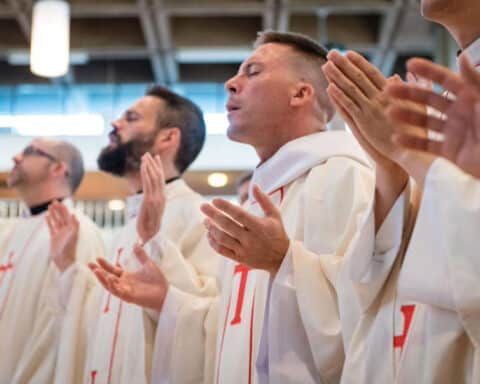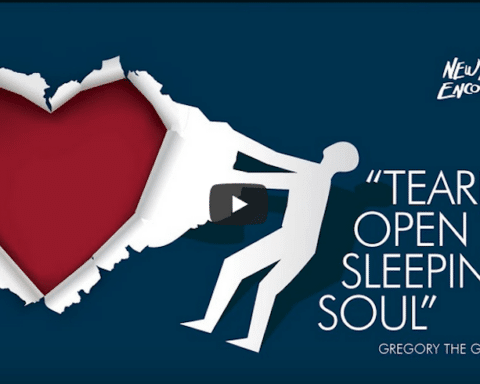It was by far the biggest decision Father John Kartje had to make in his five-year tenure as the rector and president of University of Saint Mary of the Lake/Mundelein Seminary. It was mid-March, and the Chicago priest was about to send more than 160 seminarians (from more than 30 dioceses) back to their homes.
“It was an agonizing decision — one I thought I would never have to make,” he said. “But I called our community together on a Thursday (March 12) and on Friday, our guys were packing up and heading home.”
He explained that there was a lot of surprise in the room. Some questioned the severity of the situation. Was it too drastic? However, a few days later, when a stay-at-home order was issued and much of the nation shut down, he knew he had done the right thing.
“Nearly all the bishops I heard back from were supportive of my decision. The cardinal here in Chicago was also very supportive,” he said.
Father Kartje wasn’t alone in his decision, as seminaries across the nation took heed of the COVID-19 pandemic and closed their doors. With social distancing quickly becoming the new normal, seminaries and universities were forced to change the way they form their students.
Going online
“I am very proud of our guys and how they have adapted,” said Deacon Steve Kramer, director of homiletics and assistant professor of pastoral studies at Sacred Heart Seminary in Hales Corner, Wisconsin. “These are unprecedented times, and I wasn’t sure what we were getting into.”
Deacon Kramer explained that Sacred Heart is a school that caters to second-career or older vocations.
“We have men here who are typically ages 30-35 all the way up to 60 years old,” he said. “However, we took a week off to get ready to go online, and after two weeks of this, I can say things are going well. It hasn’t been bad.”
For his homiletics class, Deacon Kramer has been having his students send in their texts and post videos of their homilies online.
“You do what you’ve got to do,” he said. “We transitioned to this within days.”
At Cathedral Seminary House of Formation in Douglastown, New York, Father George Sears echoed a similar sentiment.
“It certainly is a different dynamic,” said Father Sears, the school’s rector. “For the most part, we have adjusted well. One thing that both professors and students have been saying is that there is more written work involved. Some have commented that they look forward to the day when they can just raise their hand and answer a question as opposed to typing it out.”
It has been an easy transition for Gabriel Urquiso, 30, a first-year philosophy student for the Diocese of Pueblo, Colorado. He and another seminarian for the diocese are now living at St. Joseph Catholic Church in Grand Junction, Colorado, after being sent home from Assumption Seminary in San Antonio several weeks ago.
“All of our classes are now on Zoom, and it has been easy to adapt,” he told OSV. “Everything has been moving forward, and there have been very few struggles for me.”
Bearing fruit
Father Kartje has heard from a number of his students that they are adapting well to new living arrangements and schedules.
“A lot of our guys went to live at rectories in their home diocese, or they are living together in a small community of three or four of them,” Father Kartje said. “They are praying together with the pastor and are close (even with social distancing) to the people they will hopefully serve one day. So in many ways, they are able to keep that sense of community and liturgical rhythm that is so important in their formation.”
In New York, Father Sears has heard from his men that there is quite a bit of family evangelization taking place.
“Our students are telling me that they are inviting their family members to participate in our online liturgies and lectio divina sessions also online,” Father Sears said. “What they are doing with their families now, they will one day do with their parishioners. That is a good experience.”
Father Sears added that while many of his seminarians miss the one-on-one active ministry, he has told them that they still have a vital role to play in the eyes of the Church.
“I told the men that are now at home that their role now is to be active pray-ers,” he said. “That is another side of priesthood, and they are taking that to heart.”
In addition, Father Sears is encouraging the seminarians to stick to a daily regimen of prayer and study, just as they would in the seminary.
“Don’t become night owls and late risers,” he wrote in a letter to students and faculty. “Get up with the sun and pray morning prayer. Get as much of your academic work done in the morning when you are most productive. Pray the Mass as you watch it on TV or online and make a daily spiritual communion.”
Keeping community alive
In Yonkers, New York, second-year theology student Carlos Germosen, 23, has been heeding Father Sear’s advice.
“I have been trying to model my own daily schedule after our normal schedule at the seminary,” he said. “Morning prayer at 7:30 a.m., Mass (online now) at noon and vespers at 5:45 p.m. are the hinges of my day. Everything revolves around that.”
He told Our Sunday Visitor that it is equally important to stay connected with his brother seminarians.
“I have found that just sending a quick text to a fellow seminarian is so essential to keep that sense of community alive,” said Germosen, who is studying for the Archdiocese of New York. “I can no longer walk across the hall and check in. I have been challenged to take the initiative to reach out, as I think it is more important now than ever to keep a sense of fraternity.”
Transitional Deacon Joseph Sevcik of the Archdiocese of Dubuque, Iowa, has been able to find community through the online classes and other meetings that have continued via social media.
“The classroom dynamic has not changed that much. The same people still ask the same questions, and that serves to be humorous, for me at least. It would have been great to be able to finish out the year as normal, but this has gone remarkably well, all things considered,” said Deacon Sevcik, who was studying at Mundelein.
The road ahead
Several rectors noted that the timing of this pandemic and the disruption it has caused in their academic worlds could have been worse.
“Our semester ends May 1,” Deacon Kramer at Sacred Heart said. “So, we will just have to do this for a few more weeks. This is not a whole semester. By this point in the year, the men have come to know their professors and what is expected.”
At Mundelein, Father Kartje said that he thinks that this pandemic is one of those watershed events that will change the way the Church operates.
“I am not one to make some prophetic statement, but I think we shouldn’t have our head in the sand but rather should look at this as a movement of the Spirit,” he said. “I think it will have implications for the way seminaries operate in terms of flexibility, the role of the home diocese in formation, pedagogy and how we deliver learning and education. We need to be open to the movement of the Spirit.”
Eddie O’Neill writes from Michigan.





